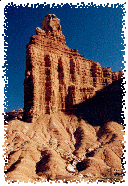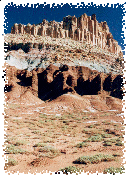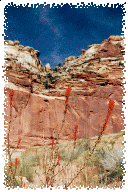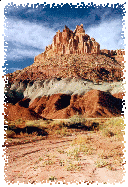
Journey with Raven • Captial Reef National Park

Impassible to settlers
 |
| The Panorama and Chimney Rock |
Capital Reef doesn't have the countless hoodoos of Bryce, the deep gorges of the Grand Canyon, nor the countless arches of Arches National Park. In the way of excesses, it may be somewhat unremarkable. But it has a little of everything.
Which is not to say that Capital Reef isn't beautiful, because it is. It is, however, a big park -- running north and south along the geological formation known as the Waterpocket Fold. Being big, several of the beautiful places are rather remote. But there's still a lot to see along scenic State Route 24, the main road through the park (as we were to soon find out.)
 |
| Chimney Rock, near the West Entrance |
We started our tour with the obligatory stop at Panorama Point near the western entrance of the park; here you can see Chimney Rock at the west edge of a long promontory of interestingly rippled stone. Looking at this face of stone, you see an almost architectural quality: almost regularly spaced crevices give the illusion of some ancient cathedral, complete with buttresses and windows. This Moenkopi layer is a rich brown, and in places resembles large slices of chocolate layer-cake. This geological layer is also interesting because it has veins of quartz crystals running through it -- huge sheets of these crystals lay exposed in the sediment pile at the base of the cliffs.
 |
| The Castle atop 200 Million Years of Sediment |
Tucked behind Panorama point is a one-mile dirt road to the Goosenecks, a meandering arm of Sulphur creek that has cut itself several feet down into the stone. In its inexorable struggle to find the path of least resistance, it almost bends upon itself in several places forming the namesake gooseneck bends.
A few miles down the road -- practically on top of the visitor's center -- is the feature known as The Castle. From top to bottom, you're able to see over two hundred million years of the Earth's history. At different times, this spot was either the bed of a shallow ocean, a shore with lapping tidal flats, or desert dunes. All of these features are evident to even the novice geologist exploring this area.
 |
| Indian Paintbrushes Bloom Between the Canyon Walls |
We ducked into the visitor center, only to discover some bad news. Alas, even though we had allowed time for exploring the park, the recent rains had so damaged several roads that many places were not accessible. (This is one thing that we Californians had to get used to: there are many parts of this area that simply aren't paved, and it's just a fact of life that dirt roads are very susceptible to the weather....) Consequently, we contented ourselves with a hike down the Grand Wash, which is still a neat hike.
 |
| The Castle as Seen from Near the Visitor's Center |
Washes, by the way, are dry riverbeds, another thing that is quite common in the area. These things fill up during the rainy season, but for the rest of the year remain bone dry. The Grand Wash Trail is a two mile trail that winds through relatively narrow gashes in the rock -- in some places barely twenty feet wide. This place was dry, but it was clear that water had flowed here recently. Indian Paintbrushes and numerous other flowers bloomed near the riverbed, and the sand bore regular ripple patterns.
Well, the sun was starting to climb lower in the sky, and signs of more weather were appearing on the horizon, so we reluctantly made our way back home, but not before we got another view of the Castle, this time from another wash that feeds into the Fremont river. There are many more places to visit at Capital Reef: the Egyptian Temple, the Golden Throne, Fern's Nipple, and Capital Dome, to name but a few.
Speaking of Capitals, you may be wondering -- as did I -- why the name Capital Reef? It turns out that many of the settlers that came this way in the last century were former men of the sea, and they used the term reef to mean any impassable obstacle, much as reefs at sea are often impassable. The rounded domes and ridges along this part of the Waterpocket Fold reminded the settlers of the great domes of the capital buildings they left behind back east, hence Capital Reefs.
Tell a Friend about this page!
unless otherwise indicated
All Rights Reserved
Reproduction or distribution without prior written permission is strictly prohibited.
Scripting and DHTML by Technomancer Software
technomancer.ws
Privacy Policy